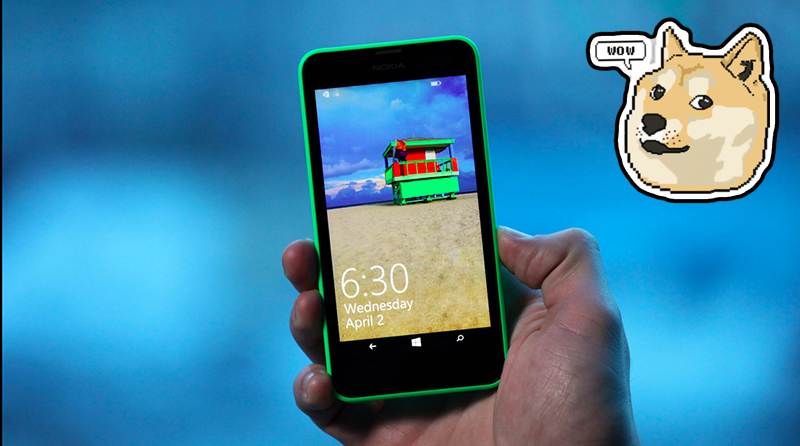Introducing New Nokia Imaging SDK 1.2 BETA and SensorCore SDK Developer Toolkits
Happy birthday Habrahabra, dear users!
As we promised during the story about the updates of the Microsoft BUILD conference, we return to the topic of new and updated developer tools.

')
Today we will talk about the SensorCore SDK, which can become the basis for fitness apps and well-being control, as well as the Nokia Imaging SDK version 1.2, which will expand the functionality of applications that somehow work with images.
The Nokia Imaging SDK toolkit is already familiar to readers of our official blog. Recall that it was designed specifically to provide developers with the necessary tools that provide much greater freedom when working with technologies related to image acquisition and processing.
It includes more than 50 photo filters, plus tools for creating your own filters and special effects, the basic mechanisms for editing images, image processing algorithms, and much more. More details about all the features of this tool can be found in our previous posts, as well as on the Nokia Developer page , and we will focus only on the main innovations in the current version.
The previous version of Nokia Imaging SDK 1.1, in addition to the main Windows Phone 8, received support for Windows 8.1 and Windows RT 8.1, expanding development capabilities to applications for tablets, laptops and PCs running on these platforms.

The new Imaging SDK 1.2 Beta also supports the new Lumia smartphones based on the presented version of Windows Phone 8.1. And this is the future bestseller Nokia Lumia 630/635 and the flagship Nokia Lumia 930 with a 20 megapixel camera, which means new audiences for your applications.
In addition, the new SDK will be fully supported by universal Windows applications , also presented at the BUILD conference.

Applications such as Nokia Lived Photos are highly dependent on the ability to create animated GIF files.

If earlier this function had to be implemented in applications independently, then now developers had the opportunity to add GIF animation processing to their applications using the updated SDK.
Another innovation in the toolkit was the Image Alignment API. It is used to digitally stabilize the image during continuous shooting (including when creating GIF images) and to eliminate blurring in all modes. This API will be especially useful on devices without PureView, in which with optical stabilization is present.
Also, developers will have access to the Local Blending API, which will allow adding applications to multi-layer image merging (read: the ability to overlay images of different sizes on each other).

This API can be used, for example, to add icons or stickers to a photo, as well as when combining images from the front and main camera to get the perfect group picture.
The new Nokia Imaging SDK 1.2 toolkit, as well as all the information you are interested in and sample applications are already available on the Nokia Developer website.
And for fans to compete in creating applications, we offer to participate in the competition Imagin8 Mission . The site added new tasks that can be performed using the Imaging SDK 1.2.
The SensorCore technology introduced at the Microsoft BUILD 2014 conference enables applications to more effectively interact with a number of sensors installed in new Lumia devices. By periodically accessing data instead of maintaining constant communication with sensors, the technology allows a significant reduction in battery consumption.

How does technology work? SensorCore is a kind of buffer between the sensors of a mobile device and installed applications. It consists of a hardware component and software solution capable of operating at low power consumption, giving data to applications only on request.
For example, a smartphone can take into account (read: accumulate) data on user actions and transfer them to the application only on request. At the same time, the smartphone will know when the owner of the smartphone walks, runs or otherwise changes his position, as well as how he moves. After processing this data, the application will be able to calculate the distance traveled, the number of calories burned, periods with a small amount of physical activity and other useful information. Potentially, a device can be programmed to perform a specific task with specific criteria defined. This approach is more efficient from the point of view of battery consumption, than ensuring continuous communication of the application with sensors.

Bing Health & Fitness app created using the Nokia SensorCore SDK
Currently, the capabilities of the SensorCore technology are implemented in Lumia 1520, Lumia Icon and Lumia 930 mobile devices. The necessary hardware will also be available in Lumia 630 and Lumia 635 models. It is no secret that this technology will be developed in future ruler models.
In order for developers to use Nokia SensorCore in their applications for Windows Phone 8.1, we have developed the SensorCore SDK toolkit, which is still being tested by partner companies, and will soon be available to all developers on our Nokia Developer website .
Nokia SensorCore SDK includes an API for working with four sensors: a pedometer, an activity monitor, a location sensor, and a route tracker. All sensors can run in the background with reduced power consumption.
As we promised during the story about the updates of the Microsoft BUILD conference, we return to the topic of new and updated developer tools.

')
Today we will talk about the SensorCore SDK, which can become the basis for fitness apps and well-being control, as well as the Nokia Imaging SDK version 1.2, which will expand the functionality of applications that somehow work with images.
Nokia Imaging SDK 1.2 BETA
The Nokia Imaging SDK toolkit is already familiar to readers of our official blog. Recall that it was designed specifically to provide developers with the necessary tools that provide much greater freedom when working with technologies related to image acquisition and processing.
It includes more than 50 photo filters, plus tools for creating your own filters and special effects, the basic mechanisms for editing images, image processing algorithms, and much more. More details about all the features of this tool can be found in our previous posts, as well as on the Nokia Developer page , and we will focus only on the main innovations in the current version.
Supports Windows Phone 8.1 and Universal Windows Applications
The previous version of Nokia Imaging SDK 1.1, in addition to the main Windows Phone 8, received support for Windows 8.1 and Windows RT 8.1, expanding development capabilities to applications for tablets, laptops and PCs running on these platforms.

The new Imaging SDK 1.2 Beta also supports the new Lumia smartphones based on the presented version of Windows Phone 8.1. And this is the future bestseller Nokia Lumia 630/635 and the flagship Nokia Lumia 930 with a 20 megapixel camera, which means new audiences for your applications.
In addition, the new SDK will be fully supported by universal Windows applications , also presented at the BUILD conference.

GIF animation support
Applications such as Nokia Lived Photos are highly dependent on the ability to create animated GIF files.

If earlier this function had to be implemented in applications independently, then now developers had the opportunity to add GIF animation processing to their applications using the updated SDK.
Another innovation in the toolkit was the Image Alignment API. It is used to digitally stabilize the image during continuous shooting (including when creating GIF images) and to eliminate blurring in all modes. This API will be especially useful on devices without PureView, in which with optical stabilization is present.
Merging pictures
Also, developers will have access to the Local Blending API, which will allow adding applications to multi-layer image merging (read: the ability to overlay images of different sizes on each other).

This API can be used, for example, to add icons or stickers to a photo, as well as when combining images from the front and main camera to get the perfect group picture.
The new Nokia Imaging SDK 1.2 toolkit, as well as all the information you are interested in and sample applications are already available on the Nokia Developer website.
And for fans to compete in creating applications, we offer to participate in the competition Imagin8 Mission . The site added new tasks that can be performed using the Imaging SDK 1.2.
Nokia SensorCore SDK
The SensorCore technology introduced at the Microsoft BUILD 2014 conference enables applications to more effectively interact with a number of sensors installed in new Lumia devices. By periodically accessing data instead of maintaining constant communication with sensors, the technology allows a significant reduction in battery consumption.

How does technology work? SensorCore is a kind of buffer between the sensors of a mobile device and installed applications. It consists of a hardware component and software solution capable of operating at low power consumption, giving data to applications only on request.
For example, a smartphone can take into account (read: accumulate) data on user actions and transfer them to the application only on request. At the same time, the smartphone will know when the owner of the smartphone walks, runs or otherwise changes his position, as well as how he moves. After processing this data, the application will be able to calculate the distance traveled, the number of calories burned, periods with a small amount of physical activity and other useful information. Potentially, a device can be programmed to perform a specific task with specific criteria defined. This approach is more efficient from the point of view of battery consumption, than ensuring continuous communication of the application with sensors.

Bing Health & Fitness app created using the Nokia SensorCore SDK
Currently, the capabilities of the SensorCore technology are implemented in Lumia 1520, Lumia Icon and Lumia 930 mobile devices. The necessary hardware will also be available in Lumia 630 and Lumia 635 models. It is no secret that this technology will be developed in future ruler models.
In order for developers to use Nokia SensorCore in their applications for Windows Phone 8.1, we have developed the SensorCore SDK toolkit, which is still being tested by partner companies, and will soon be available to all developers on our Nokia Developer website .
Nokia SensorCore SDK includes an API for working with four sensors: a pedometer, an activity monitor, a location sensor, and a route tracker. All sensors can run in the background with reduced power consumption.
Source: https://habr.com/ru/post/219929/
All Articles